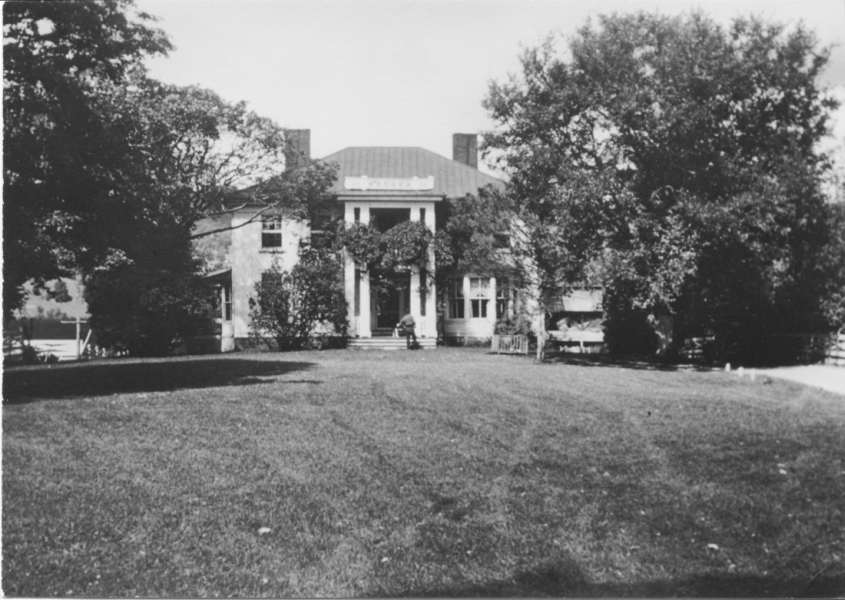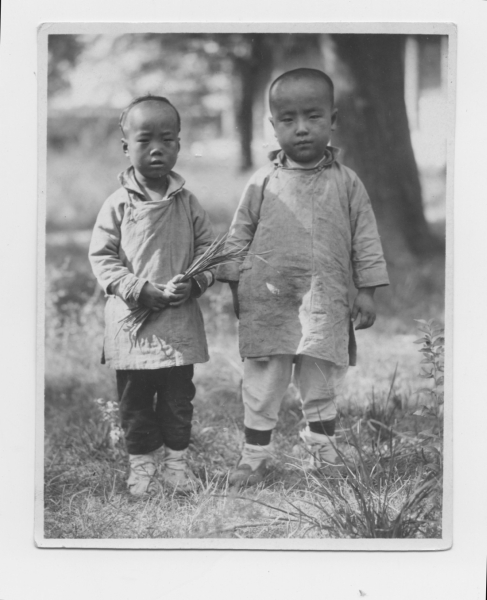Bridge for Passing (26 page)
Read Bridge for Passing Online
Authors: Pearl S. Buck

And here I tell a story that has nothing to do with the picture, except that it provides a closing scene for myself. When I was looking for the new apartment a daughter helped me by sorting out the impossibles and bringing me at last to see the two or three possibles. It was night, I remember, when I looked at these places. I was in haste and it did not seem to matter much where I lived. We entered bare un-painted rooms. I saw a wide window and through the darkness I discerned dimly a building whose roof faced my window, a school, my daughter said, and fortunate for me, for there would be no high building to cut off the view. I did not care very much about that, either, for when do I have time in New York to look at a view? Besides, I have plenty of view in my Pennsylvania home. So I decided upon impulse.
“I’ll take it.”
The choice was haphazard, I would have said, a chancy thing. But I am beginning to believe that there is no such thing as pure chance in this world. For here is the preliminary to this closing story:
When I was a child and often reluctant to do my duty, my father used to say to me firmly but gently,
“If you will not do it because it is right, then do it for the greater glory of God.”
For the greater glory of God then, and for my father’s sake, though still reluctant, I did do what had to be done, at least as often as possible.
Now to return to the apartment. I did not once see it while it was being decorated. When all was finished I opened the door and went straight to the big window. It was a bright day, I remember, one of New York’s best, the air fresh from the sea and the sky blue. And facing me, across the building, under the eaves and along the roof, I saw these words carved in huge stone letters:
AD MAIOREM DEI GLORIAM
They face me now as I write. To the greater glory of God! What does it mean, this voice from the grave, my father’s grave? He lies buried on a mountaintop in the very heart of a China lost to me. I am here and alive and thousands of miles away. Are we in communication, he and I, through my father? It is not possible.
How dare I say it is not?
Some day we shall know. What day? That day, perhaps, when saints and scientists unite to make a total search for truth. It is the saints, the believers, who should have the courage to urge the scientists to help them discover whether the spirit continues its life of energy when the mass we call body ceases to be the container. Faith supplies the hypothesis, but only science can provide the computor for verification. The unbeliever will never pursue the search. He is already static, a pillar of salt, forever looking backward.
There are no miracles, of that I am sure. If one walks on water and heals the sick and raises the dead to life again, it is not a matter of magic but a matter of knowing how to do it. There is no supernatural; there is only the supremely natural, the purely scientific. Science and religion, religion and science, put it as I may, they are two sides of the same glass, through which we see darkly until these two, focusing together, reveal the truth.
On the day when the message comes through from over the far horizon where dwells “that great majority,” the dead, the proof will reach us, not as a host of angels in the sky but as a wave length recorded in a laboratory, a wave length as indisputable and personal as the fingerprint belonging to someone whose body is dust. Then the scientist, recognizing the wave length, will exclaim, “But that’s someone I know! I took his wave length before he died.” And he will compare his record with the wave length just recorded and will know that at last a device, a machine, is able to receive a message dreamed of for centuries, the message of the continuing individual existence, which we call the immortality of the soul.
Or perhaps it will not be a scientist who receives, but a woman, waiting at a window open to the sky.
Pearl S. Buck (1892–1973) was a bestselling and Nobel Prize-winning author of fiction and nonfiction, celebrated by critics and readers alike for her groundbreaking depictions of rural life in China. Her renowned novel
The Good Earth
(1931) received the Pulitzer Prize and the William Dean Howells Medal. For her body of work, Buck was awarded the 1938 Nobel Prize in Literature—the first American woman to have won this honor.
Born in 1892 in Hillsboro, West Virginia, Buck spent much of the first forty years of her life in China. The daughter of Presbyterian missionaries based in Zhenjiang, she grew up speaking both English and the local Chinese dialect, and was sometimes referred to by her Chinese name, Sai Zhenzhju. Though she moved to the United States to attend Randolph-Macon Woman’s College, she returned to China afterwards to care for her ill mother. In 1917 she married her first husband, John Lossing Buck. The couple moved to a small town in Anhui Province, later relocating to Nanking, where they lived for thirteen years.
Buck began writing in the 1920s, and published her first novel,
East Wind: West Wind
in 1930. The next year she published her second book,
The Good Earth
, a multimillion-copy bestseller later made into a feature film. The book was the first of the Good Earth trilogy, followed by
Sons
(1933) and
A House Divided
(1935). These landmark works have been credited with arousing Western sympathies for China—and antagonism toward Japan—on the eve of World War II.
Buck published several other novels in the following years, including many that dealt with the Chinese Cultural Revolution and other aspects of the rapidly changing country. As an American who had been raised in China, and who had been affected by both the Boxer Rebellion and the 1927 Nanking Incident, she was welcomed as a sympathetic and knowledgeable voice of a culture that was much misunderstood in the West at the time. Her works did not treat China alone, however; she also set her stories in Korea (
Living Reed
), Burma (
The Promise
), and Japan (
The Big Wave
). Buck’s fiction explored the many differences between East and West, tradition and modernity, and frequently centered on the hardships of impoverished people during times of social upheaval.
In 1934 Buck left China for the United States in order to escape political instability and also to be near her daughter, Carol, who had been institutionalized in New Jersey with a rare and severe type of mental retardation. Buck divorced in 1935, and then married her publisher at the John Day Company, Richard Walsh. Their relationship is thought to have helped foster Buck’s volume of work, which was prodigious by any standard.
Buck also supported various humanitarian causes throughout her life. These included women’s and civil rights, as well as the treatment of the disabled. In 1950, she published a memoir,
The Child Who Never Grew
, about her life with Carol; this candid account helped break the social taboo on discussing learning disabilities. In response to the practices that rendered mixed-raced children unadoptable—in particular, orphans who had already been victimized by war—she founded Welcome House in 1949, the first international, interracial adoption agency in the United States. Pearl S. Buck International, the overseeing nonprofit organization, addresses children’s issues in Asia.
Buck died of lung cancer in Vermont in 1973. Though
The Good Earth
was a massive success in America, the Chinese government objected to Buck’s stark portrayal of the country’s rural poverty and, in 1972, banned Buck from returning to the country. Despite this, she is still greatly considered to have been “a friend of the Chinese people,” in the words of China’s first premier, Zhou Enlai. Her former house in Zhenjiang is now a museum in honor of her legacy.

Buck’s parents, Caroline Stulting and Absalom Sydenstricker, were Southern Presbyterian missionaries.

Buck was born Pearl Comfort Sydenstricker in Hillsboro, West Virginia, on June 26, 1892. This was the family’s home when she was born, though her parents returned to China with the infant Pearl three months after her birth.

Buck lived in Zhenjiang, China, until 1911. This photograph was found in her archives with the following caption typed on the reverse: “One of the favorite locations for the street barber of China is a temple court or the open space just outside the gate. Here the swinging shop strung on a shoulder pole may be set up, and business briskly carried on. A shave costs five cents, and if you wish to have your queue combed and braided you will be out at least a dime. The implements, needless to say, are primitive. No safety razor has yet become popular in China. Old horseshoes and scrap iron form one of China’s significant importations, and these are melted up and made over into scissors and razors, and similar articles. Neither is sanitation a feature of a shave in China. But then, cleanliness is not a feature of anything in the ex-Celestial Empire.”

Buck’s writing was notable for its sensitivity to the rural farming class, which she came to know during her childhood in China. The following caption was found typed on the reverse of this photograph in Buck’s archive: “Chinese beggars are all ages of both sexes. They run after your rickshaw, clog your progress in front of every public place such as a temple or deserted palace or fair, and pester you for coppers with a beggar song—‘Do good, be merciful.’ It is the Chinese rather than the foreigners who support this vast horde of indigent people. The beggars have a guild and make it very unpleasant for the merchants. If a stipulated tax is not paid them by the merchant they infest his place and make business impossible. The only work beggars ever perform is marching in funeral and wedding processions. It is said that every family expects 1 or 2 of its children to contribute to support of family by begging.”

